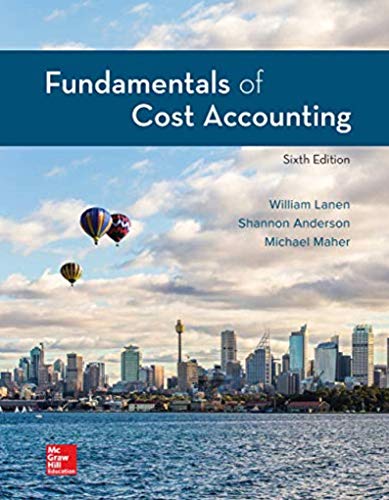
Fundamentals Of Cost Accounting (6th Edition)
6th Edition
ISBN: 9781259969478
Author: WILLIAM LANEN, Shannon Anderson, Michael Maher
Publisher: McGraw Hill Education
expand_more
expand_more
format_list_bulleted
Question
Chapter 15, Problem 23E
a.
To determine
Determine the impact on the cost of the product with respect to the information given in the question.
b.
To determine
Determine the cost incurred with respect to the information given in the question.
Expert Solution & Answer
Trending nowThis is a popular solution!

Students have asked these similar questions
Get correct answer this general accounting question
Hi expert please give me answer general accounting question
Do fast answer of this accounting questions
Chapter 15 Solutions
Fundamentals Of Cost Accounting (6th Edition)
Ch. 15 - What is the purpose of a transfer price?Ch. 15 - Prob. 2RQCh. 15 - Prob. 3RQCh. 15 - What are the limitations of market-based transfer...Ch. 15 - Prob. 5RQCh. 15 - When would you advise a firm to use prices other...Ch. 15 - What is the basis for choosing between actual and...Ch. 15 - What are the advantages and disadvantages of a...Ch. 15 - Prob. 9RQCh. 15 - Why is transfer pricing important in tax...
Ch. 15 - Prob. 11RQCh. 15 - What should an effective transfer pricing system...Ch. 15 - Prob. 13CADQCh. 15 - Prob. 14CADQCh. 15 - Refer to the Business Application item, Transfer...Ch. 15 - Prob. 16CADQCh. 15 - Prob. 17CADQCh. 15 - In what ways is transfer pricing like cost...Ch. 15 - In Chapter 12, we discussed corporate cost...Ch. 15 - Prob. 20ECh. 15 - Prob. 21ECh. 15 - Apply Transfer Pricing Rules Best Practices, Inc.,...Ch. 15 - Prob. 23ECh. 15 - Prob. 24ECh. 15 - Evaluate Transfer Pricing System Southwest...Ch. 15 - Prob. 26ECh. 15 - Evaluate Transfer Pricing System Carmen Seville...Ch. 15 - Prob. 28ECh. 15 - Prob. 29ECh. 15 - Prob. 30ECh. 15 - Prob. 31ECh. 15 - Prob. 32ECh. 15 - Prob. 33ECh. 15 - Prob. 34ECh. 15 - Prob. 35ECh. 15 - Segment Reporting Leapin Larrys Pre-Owned Cars has...Ch. 15 - Segment Reporting Perth Corporation has two...Ch. 15 - Prob. 38PCh. 15 - Prob. 39PCh. 15 - Prob. 40PCh. 15 - International Transfer Prices Skane Shipping Ltd....Ch. 15 - International Transfer Prices Badger Air is an...Ch. 15 - Prob. 43PCh. 15 - Prob. 44PCh. 15 - Prob. 45PCh. 15 - Weaver, Inc., is a large consumer products...Ch. 15 - Western States Supply, Inc. (WSS), consists of...Ch. 15 - Prob. 48PCh. 15 - Midwest Entertainment has four operating...Ch. 15 - Prob. 50PCh. 15 - Mathes Corporation manufactures paper products....Ch. 15 - Refer to the data in Problem 15-51. At the end of...Ch. 15 - CHS is a large multidivision firm. One division,...Ch. 15 - Prob. 54PCh. 15 - Prob. 56IC
Knowledge Booster
Similar questions
arrow_back_ios
SEE MORE QUESTIONS
arrow_forward_ios
Recommended textbooks for you
 Managerial Accounting: The Cornerstone of Busines...AccountingISBN:9781337115773Author:Maryanne M. Mowen, Don R. Hansen, Dan L. HeitgerPublisher:Cengage Learning
Managerial Accounting: The Cornerstone of Busines...AccountingISBN:9781337115773Author:Maryanne M. Mowen, Don R. Hansen, Dan L. HeitgerPublisher:Cengage Learning Managerial AccountingAccountingISBN:9781337912020Author:Carl Warren, Ph.d. Cma William B. TaylerPublisher:South-Western College Pub
Managerial AccountingAccountingISBN:9781337912020Author:Carl Warren, Ph.d. Cma William B. TaylerPublisher:South-Western College Pub Financial And Managerial AccountingAccountingISBN:9781337902663Author:WARREN, Carl S.Publisher:Cengage Learning,
Financial And Managerial AccountingAccountingISBN:9781337902663Author:WARREN, Carl S.Publisher:Cengage Learning,

Managerial Accounting: The Cornerstone of Busines...
Accounting
ISBN:9781337115773
Author:Maryanne M. Mowen, Don R. Hansen, Dan L. Heitger
Publisher:Cengage Learning

Managerial Accounting
Accounting
ISBN:9781337912020
Author:Carl Warren, Ph.d. Cma William B. Tayler
Publisher:South-Western College Pub

Financial And Managerial Accounting
Accounting
ISBN:9781337902663
Author:WARREN, Carl S.
Publisher:Cengage Learning,